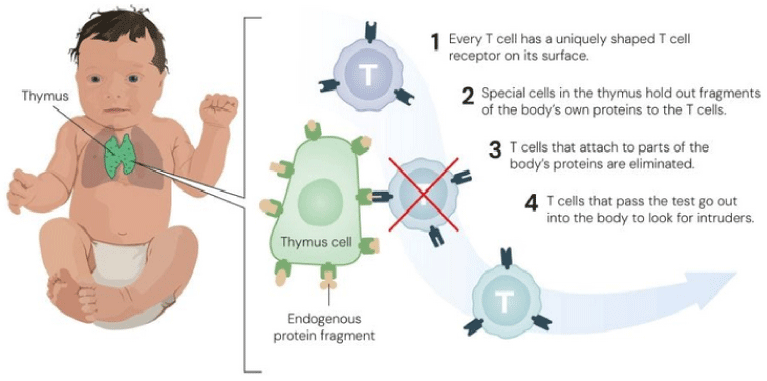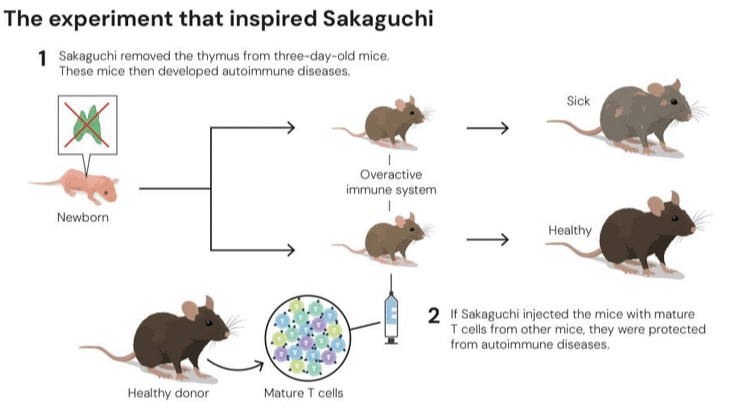2025 Nobel Prize in Physiology or Medicine
- gdfuhk
- Oct 7
- 4 min read
Updated: Oct 12
David Fu, Oct 7, 2025
At 11:30 a.m. local time on October 6, 2025, the Nobel Prize in Physiology or Medicine was announced and awarded to three scientists — American researchers Mary E. Brunkow and Fred Ramsdell, and Japanese scientist Shimon Sakaguchi — for their discovery of peripheral immune tolerance.
In short: they uncovered the secret of how the immune system restrains itself.

Every moment, our immune system protects us from thousands of microorganisms that try to invade our bodies. These microorganisms vary in appearance, and many have even evolved to resemble human cells as a form of disguise. So how does the immune system decide whether to attack or defend? And why don't we all develop severe autoimmune diseases?
Immune tolerance operates on two levels:
Central tolerance — formed in the thymus or bone marrow during the development of T or B cells. It works mainly through negative selection, eliminating self-reactive lymphocytes with high affinity.
Peripheral tolerance — maintained in peripheral tissues to suppress self-reactive lymphocytes that escape central tolerance.
As T cells mature in the thymus, they undergo a process of selection that eliminates those that recognize the body’s own (endogenous) proteins (Figure 1). This selection process is called central tolerance.

Figure 1. Central tolerance shows how harmful T cells are eliminated. T cells mature in the thymus. Those recognize the body’s own (endogenous) proteins are sorted and removed. This selection process is central tolerance.
Autoimmune diseases, at their core, result from a loss or breakdown of immune tolerance — the immune system fails to recognize self-tissues and mistakenly attacks them as “foreign invaders.”
In the 1990s, most immunologists firmly believed that the discipline of the immune system depended entirely on the thymus.
Sakaguchi’s insight: the immune system must have a security guard
Shimon Sakaguchi was inspired by a paradoxical experiment his colleagues had previously conducted. To understand the role of the thymus in T cell development, they surgically removed the thymus from newborn mice. They hypothesized that these mice would develop fewer T cells and have weaker immune systems. However, if the surgery was performed after the mice were three days old, their immune systems became overactive and out of control, leading to a range of autoimmune diseases.
To better understand this phenomenon, in the early 1980s, Shimon Sakaguchi isolated T cells that had matured in genetically identical mice and injected them into mice without thymus. This yielded an intriguing result: the presence of T cells that appeared to protect the mice from autoimmune diseases (Figure 2).

Figure 2. The experiment that inspired Sakaguchi
Sakaguchi discovers a new class of T cells
In 1995, Professor Shimon Sakaguchi discovered the regulatory T cells (Tregs) that suppress excessive immune responses — acting like the “security guards” of the immune system (Figure 3), monitoring potentially rogue immune soldiers. These cells prevent overreactions that can lead to autoimmune disorders or unchecked tumor growth.

Figure 3. Sakaguchi defines a new class of T cells. Sakaguchi showed that the T cells with CD25 on their surface protect against autoimmune diseases through an experiment in mice that lacked T cells. If he injected CD4-bearing T cells into the mice, but removed all the cells with CD25, the mice developed serious autoimmune diseases. If he added CD25-bearing cells, the mice remained healthy.
Mary Brunkow and Fred Ramsdell identified the new gene Foxp3
Then, in 2001, Brunkow and Ramsdell discovered the gene Foxp3, which controls Tregs — a mutation in this gene leads to premature termination of protein expression (Figure 4). When Foxp3 is damaged, the body can no longer produce those “security guards,” resulting in widespread immune chaos and attacks on the body’s own organs.

Figure 4. Brunkow and Ramsdell find the scurfy mutation
Regulatory T cells – the body’s security guards
Two years later, Shimon Sakaguchi (and others) convincingly demonstrated that the FOXP3 gene controls the development of regulatory T cells (Tregs). These cells prevent other T cells from mistakenly attacking the body’s own tissue (Figure 5), which is important for a process called peripheral immune tolerance. Regulatory T cells also ensure the immune system calms down after it has eliminated an invader, so it does not continue working at top speed.

Figure 5. How regulatory T cells protect us
Sakaguchi’s insights represent the philosophy of immunity; Brunkow and Ramsdell’s work embodies the engineering of immunity.
The Foxp3 gene serves as the master switch essential for the development and function of regulatory T cells (Tregs). Without Foxp3, Tregs cannot function properly, and the immune system loses control—turning against the body itself. This is the essence of what we now understand as immune tolerance—how the body avoids becoming its own enemy.
Value and prospects
This fundamental research has had a profound impact on modern medicine:
Deeper understanding of autoimmune diseases: Conditions such as rheumatoid arthritis and type 1 diabetes may arise from dysfunction of regulatory T cells, offering new explanations for their underlying causes.
Opening new therapeutic avenues: Building on these discoveries, scientists are developing treatments designed to restore or enhance regulatory T cell function to treat autoimmune diseases—or, conversely, to temporarily suppress Tregs so the immune system can attack cancer cells more effectively.
Award-winning key publications
Sakaguchi, S., N. Sakaguchi, M. Asano, M. Itoh, and M. Toda. 1995. 'Immunologic self-tolerance maintained by activated T cells expressing IL-2 receptor alpha-chains (CD25). Breakdown of a single mechanism of self-tolerance causes various autoimmune diseases', J Immunol, 155:1151-64.
Brunkow, M. E., E. W. Jeffery, K. A. Hjerrild, B. Paeper, L. B. Clark, S. A. Yasayko, J. E. Wilkinson, D. Galas, S. F. Ziegler, and F. Ramsdell. 2001. 'Disruption of a new forkhead/winged-helix protein, scurfin, results in the fatal lymphoproliferative disorder of the scurfy mouse', Nat Genet, 27: 68-73.
Hori S, Nomura T, Sakaguchi S. Control of regulatory T cell development by the transcription factor Foxp3. Science. 2003:299:1057-1061.
References
Nobel Prize in Physiology or Medicine 2025. NobelPrize.org. Nobel Prize Outreach 2025. Tue. 7 Oct 2025. <https://www.nobelprize.org/prizes/medicine/2025/summary/>

Comments